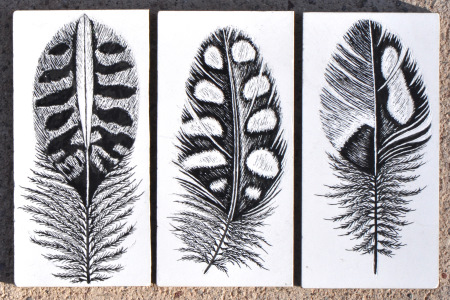Stampbord Drawings
July 29, 2011
I recently bought a package of Ampersand Stampbord tiles. It contains about 50 assorted tiles in four sizes: 1 x 1 inch, 2 x 2 inches, 1 x 2 inches, and 1.25 x 2.5 inches. (Stampbord is also available in a business card size, which I may try next time). As the name suggests, stampbord is sold primarily as a surface for decorative rubber stamp projects, including mixed media collage. The smaller sizes can even be drilled and made into jewelry. Although not marketed as a drawing surface, stampbord is nearly identical to Ampersand’s Claybord Smooth, a multimedia artboard that I use for most of my ink drawings. The only difference is that the stampbord surface is less consistent than claybord. The stampbord has slight variations from piece to piece in the thickness and hardness of the white clay layer, and many pieces have tiny chips, dings, or discolorations. None of this would matter for crafts like rubber stamping, or even for pencil drawing or painting. It is probably only an issue for scratchboard, and even then it’s minor and easy to work around.
These tiles are perfect for tiny drawings and for experimenting with new techniques, media or subjects. Obviously they are well adapted to any project that calls for multiple drawings. (Creating a Tarot deck causes a permanent rewiring of the brain, causing some artists to become permanently addicted to working in a series – it’s hard for them to make just one of anything.)
Here are Midnight Louie (left) and Lin (right) as ancient Chinese tomb guardians. The cats were drawn from photos, and you can see how different they were – ML had a big head, heavy body, and unusually short legs, while Lin was small, wiry, and muscular. The Chinese tomb guardians, sometimes called “earth spirits”, were clay figures that were supposed to protect the soul of the deceased. They come in pairs, and often have elaborate wings, horns, hooves, etc. One is usually stout and seated, with a man’s face with large pointed ears and a single twisted horn, and the other is thinner and more active looking with a feline or canine face with a pair of horns. A few months ago, I took a photo of Lin with half-closed eyes that reminded me of one of these figures, so it seemed like a natural memorial for him. These are 2.5 x 1.25 inch tiles.

Tomb Guardians
Here are the smaller 1 x 2 inch boards with feathers from a male Arizona quail (also called Montezuma quail), drawn life size.

Arizona Quail Feathers
Here’s the larger rectangle again, with three similar species of Usnea lichen. All three are shrubby grayish-green species that grow on twigs and have abundant cuplike apothecia (spore-bearing structures). These are drawn about twice life size.
LEFT: Usnea strigosa, Outer Banks, North Carolina. Apothecia are pinkish on top and have scattered fibrils on the underside.
CENTER: Usnea intermedia (U. arizonica), southern Arizona. Apothecia are green on top and have rare elongate fibrils on the underside.
RIGHT: Usnea cirrosa, southern Arizona. Apothecia are green on top and have abundant bristly fibrils on the underside.

Usnea Lichen Apothecia
I’m still working with the 1 and 2 inch sqares tiles, and plan to try some mixed drawing/painting/metal projects with those.
These are lovely, Lorena. I am fascinated with the way you are able to do such fine detail.
I use the tip of a standard small triangular X-acto knife blade to scratch off details. The feathers were drawn mostly in black, with the details scratched off. The three lichen drawings (and the downy parts of the feathers) were done with a #.005 Pigma Micron marker (very fine point), and the tips of the lines were refined with the knife to give them sharp tapered points. The technique can be tedious but is not difficult.